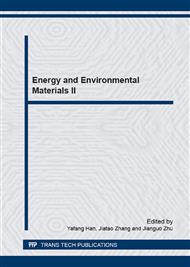[1]
X.Z. Huang, The distribution of asbestos in China, Non Metallic Mine. 6(1986)1-5.
Google Scholar
[2]
P. Wan, H.Y. Li, Z.Y. Lu, The utilization research of serpentine used for fertilzer and refractory, Non Metallic Mine. 108(1995)30-32.
Google Scholar
[3]
P. Wan, H.Y. Li, The prospect of serpentine directly used as mineral fertilizer, Non Metallic Mine. 1(1991)41-43.
Google Scholar
[4]
L. Yu, The experiment research of producing refractory materials with serpentine, Multipurpose Utilization of Mineral Resources. 6(2003)47-51.
Google Scholar
[5]
B.J. Yang, A new technology of comprehensive utilization of serpentine, Mining And Metallurgical Engineering. 1(2003) 47-49.
Google Scholar
[6]
Z.W. Hu,L.X. Wang B.J. Yang, Purification of magnesium by sulfuric acid leaching filtrate of serpentine for preparation of acicular nanometer magnesium hydroxide, Non Metallic Mine. 1(2005)35-36.
Google Scholar
[7]
Y.P. Jiang H.J. Sun T.J. Peng, Research on preparation of SiO2 Nano-particles by activation products of chrysotile asbestos tailings, China Powder Science and Technology. 17(2011)154-155.
Google Scholar
[8]
Y.P. Jiang H.J. Sun T.J. Peng, Study on calcined chrysotile asbestos tailing leaching in acid, Non Metallic Mine. 6(2010)7-10.
Google Scholar
[9]
Y. Wan S.M. Yu,Y.L. Lu, The experiment research on sulfuric acid leaching of serpentine after microwave irradiation, Acta Mineralaogic. 4(2004)347-350.
Google Scholar
[10]
L. Zeng ,H.J. Sun T.J. Peng, Research of magnesium extracted from asbestos tailings by ammonium sulfate calcinations method, Non Metallic Mine. 2(2012)8-11.
Google Scholar
[11]
C.B. Sun,P. Zhu, Metals separated from serpentine tailings leaching solution using solvent extraction, China Resources Comprehensive Utilization. 3(2010)19-22.
Google Scholar
[12]
Y. Tan F.Q. Dong Q.W. Dai, The research of leaching cobalt and nickel from serpentine with Aspergillus, Journal of Mineralogy and Petrology. 3(2009)115-119.
Google Scholar
[13]
X.J. Xue L.J. Wang A.H. Lu, A discussion on activation mechanism of atom groups in serpentine, Acta Petrologica et Mineralogica. 4(2003)386-390.
Google Scholar
[14]
G.J. Li,Z.M. Bai W.J. Wang, Research of serpentine powder surface modification, Bulletin of the Chinese Ceramic Society. 6(2008)1091-1095.
Google Scholar
[15]
K. Zhi, The research on the treatment of copper wastewater with serpentine, Environmental Science and Technology. 2(1997)17-19.
Google Scholar
[16]
J.X. Guo C.G. Yuan, The research on the treatment of heavy metal from waste water with serpentine, Fine Chemicals. 10(2000)586-590.
Google Scholar
[17]
J.X. Guo C.G. Yuan, The experimental study of COD treatment from petroleum wastewater with adsorption method—the choose of adsorbent and adsorption conditions, Fine Chemicals. 7(2000)522-525.
Google Scholar
[18]
Q.M. Feng,Q. Wang,K. Liu, Adsorption kinetics and thermodynamics of copper(II) on chrysotile, Journal of Central South University(Science and Technology). 11(2011)3225-3231.
Google Scholar
[19]
FENG B, LU Y, FENG Q, Mechanisms of surface charge development of serpentine mineral, T Nonferr Metal Soc, 4(2013)1123-1128.
Google Scholar
[20]
Yu HL, Xu Y, Shi PJ, Tribological behaviors of surface-coated serpentine ultrafine powders as lubricant additive, . Tribol Int. 3(2010)667-675.
DOI: 10.1016/j.triboint.2009.10.006
Google Scholar
[21]
Zhang B, Xu Y, Gao F, Sliding friction and wear behaviors of surface-coated natural serpentine mineral powders as lubricant additive, Appl Surf Sci. 7(2011)2540-2549.
DOI: 10.1016/j.apsusc.2010.10.019
Google Scholar
[22]
H.L. Yu,H.M. Wang K.K. Zhao, Mechanical and tribological properties of the tribofilm using serpentine minerals as additives, The 2011 national youth tribology and surface engineering academic conference. (2011)6.
Google Scholar
[23]
B.S. Zhang B.X. Xun,Y. Xu, Self-restoration effect and action mechanism of tribopairs consisting of analogue shaft-bushing induced by serpentine powders, Materials Science And Engineering of Powder Metallurgy. 3(2013)346-352.
Google Scholar
[24]
W. Zheng Z.Z. Zhang F.X. Zhao, The heat treatment of serpentine and its effect on the tribological properties of base oil, Petroleum Processing and Petrochemicals. 3(2013)71-74.
Google Scholar
[25]
Yu H, Xu Y, Shi P, Microstructure, mechanical properties and tribological behavior of tribofilm generated from natural serpentine mineral powders as lubricant additive, Wear. 297(2013)802-810.
DOI: 10.1016/j.wear.2012.10.013
Google Scholar
[26]
W S. CO2 disposal by means of silicates, Nature. 6257(1990)486.
Google Scholar
[27]
J.S. Zhang,R. Zhang J.C. B, Fundamental research on CO2 mineralization: I. Leaching kinetics of forsterite and serpentine with hydrochloric acid, Journal of Fuel Chemistry and Technology. 9(2011)706-711.
Google Scholar
[28]
W.Z. Li,W. Li,B.Q. Li, Using electrolytic method to promote CO2 sequestration in serpentine by mineral carbonation, Journal of China University of Mining & Technology. 6(2007)817-821.
Google Scholar
[29]
Y. Hen J.Y. Zhang Z.L. Wang, CO2 sequestration by direct mineral carbonation of serpentine under medium and low pressure, Journal of Fuel Chemistry and Technology. 6(2013)748-753.
Google Scholar


